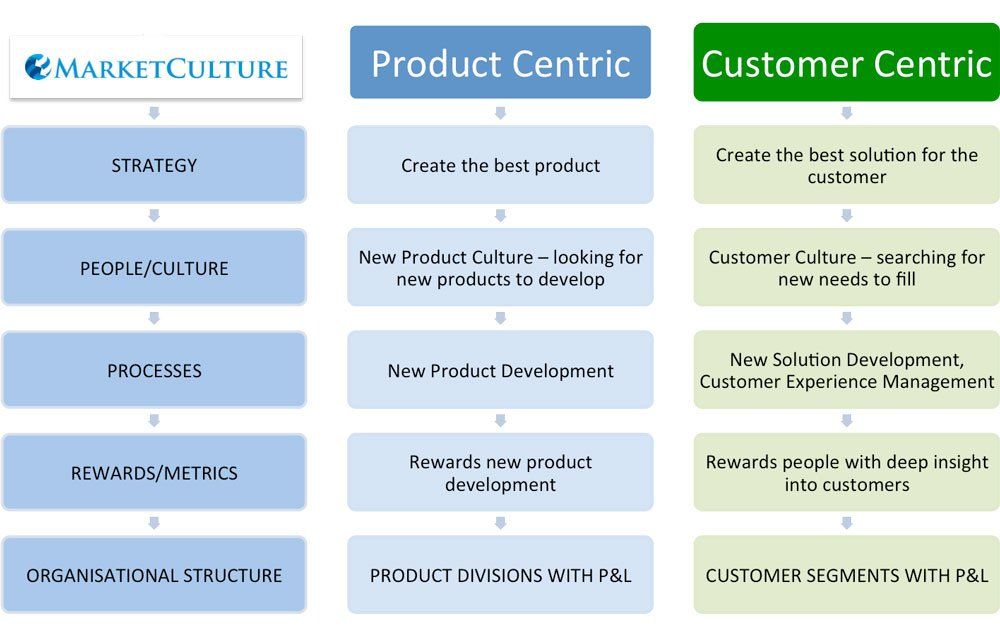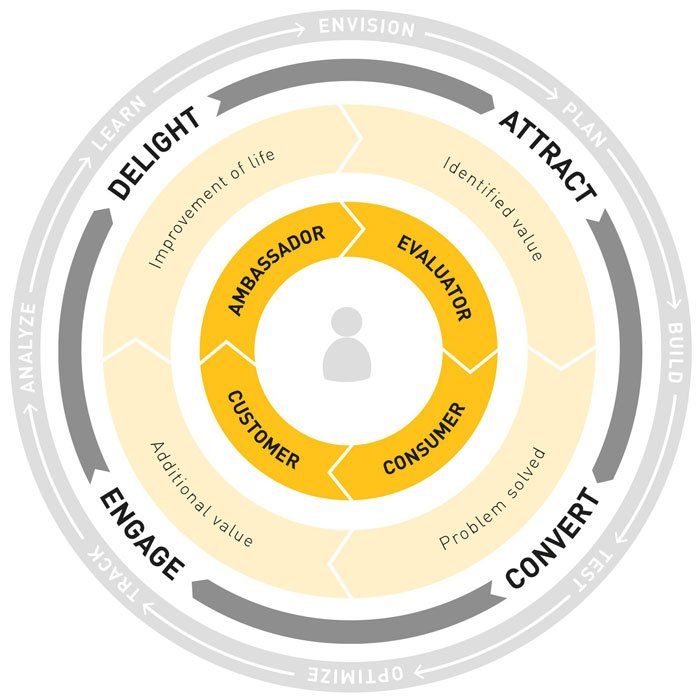Product Centric vs Customer Centric [Is There a Winner?]
Are you curious to see if there can be a clear winner?
There is value gained with both product centric and customer centric approaches. As we'll see it's best not to pick a side in this battle. The ideal strategy is a balance of both.
Finding that balance certainly isn't easy. In this article, we'll give you a rundown of each approach, their pros and cons, and a way you can get the best of both worlds.

What does a product centric approach mean?
One of the most memorable lines of cinema comes from the 1989 Kevin Costner film Field of Dreams. The line in the movie is “If you build it, they will come.”
In a nutshell, that’s the theory behind product centric.
The term “product” refers to any tangible or intangible asset used by a business to create value. This includes products, services, brands, intellectual property rights, and more.
And you have probably heard “centric” before. It brings to mind your eccentric old uncle Harvey who wears mismatched socks and rides a tricycle through your village square every morning.
The Latin root of eccentric can be traced to ex meaning “out of” and centric meaning “center.” In other words, your uncle Harvey is not centred at all.
Product centric, on the other hand, is very centered - centred around the product.
Product centricity is when a company values its products over everything else. Its products are at the center of the company's operations and value proposition.
The company's team is driven to create and iterate on advanced products that drive sales. Even when there isn't an existing market or perceived need for it.
With this approach, there is a heavy focus on invention and innovation.
A lot of investment (either money, time or both) is put toward R&D to develop new products. Then even more investments are made towards marketing and sales to raise awareness both for the product and the need for it.
A product centric approach can be seen in marketing material that highlights unique features rather than benefits. Like ads for the car industry.
Trying to reinvent the wheel can be a costly and risky approach.
But some product-centric companies like Apple, Google, and Tesla have nonetheless managed to squeeze out a decent living.
Benefits of a product centric approach
1. Has the potential to place your brand at the forefront of innovation in your industry. No one remembers the runner who comes in second place, but they certainly remember the first person to cross the finish line.
2. Allows your team to leverage their specialized skills. And maintain a singular focus on creative pursuits. You're expanding product lines and improving on products that work; quickly killing off those that don't.
3. Can create a powerful brand positioning wherein you're considered best in class. And can then set the benchmark your competitors must keep up with.
4. Gives you the power to set premium pricing with greater profit margins.
Weaknesses of product centric approach
1. You potentially ignore customer needs and challenges.
2. You neglect defining one of the most important foundations of any business - product market fit. Without it, even the brightest minds in the world can invest millions and even billions into a product that ultimately fails (I.e. Google Glass).
3. You are forced to create marketing campaigns that target the notoriously costly problem unaware stage. Meaning you must educate and convince early adopters in the market to give your product a try.
4. Once you've done the heavy lifting raising awareness, competitors can piggyback off your marketing efforts and even undersell you.
5. Without the budget for marketing, it places considerable hope that the product can ultimately sell itself. (I.e. A 'build and they will come' approach.)
6. Your departments operate within distinct silos which make it difficult for them track customers across the complete buyer’s journey.
What does it mean to have a customer centric approach?
You guessed it - customer centricity centers on the customer.
It emphasizes customer success above everything else - including product innovation. It’s a term that's been around for years, but with competition in industries intensifying, it has become increasingly important.
It involves a company-wide focus on solving the needs, challenges, and pain-points of your ideal customers. The customer centric strategy focuses less on product features and more on delivering the best solution to your customer in mind.
What is Ideal Customer Focused?
Let's face it - not all customers are equal. There are some that may, on paper, generate some income, but result in a loss for all the resources and time they require.
On the flip side, there are customers that match your chemistry. You deliver value to them; they are happy, spread word of mouth, and you live happily ever after. These are the customers you want to attract.
For this, value must be delivered throughout the entire customer journey. This includes effective content to support the buyer's journey. And even tender loving care after a sale to propel continuous business growth. You obsess over the customer experience to ultimately gain customer loyalty.
Walmart, Amazon, and Zappos are three examples of customer centric companies who have done fairly decent for themselves with this approach.
Best Customer Centric Companies
Some of the biggest companies in the world today built their brand from being customer centric.
Walmart, Amazon, and Zappos are three examples of customer centric companies who have done fairly decent for themselves with this approach.
Benefits of a customer centric approach
1. You are entering the market to solve an existing problem based on existing customer demand and thus take on less risk.
2. Your marketing and sales teams can focus on the solutions you provide to consumers. Those who are already fully aware of the problem and are hungry for solutions.
3. All customer-facing departments work together to improve customer lifetime value.
4. Centers the company culture and all processes around satisfying your customers, which reflects positively in every aspect of your business.
5. As you become synonymous with customer satisfaction, you give and receive. And any research your prospective customers do will likely be in your favor.
6. A continuation of #5, the reviews and word of mouth spread by a current customer have the potential to grow your sales exponentially. Your customers can recommend you to their networks of other like-minded target customers.
7. With a focus on collecting and organizing data in your CRM for all customer facing teams, you gain a 360 degree view of your customer. You better understand customer behavior and can segment accordingly, highlighting the type of customers most profitable for your business.
8. You enjoy a relatively low cost per lead as your proactive customer service compels users to reciprocate and bring leads to you.
Weaknesses of a customer centric approach
1. Can be time and cost intensive to do effective and accurate market research.
2. There is a greater need for departments to stay updated on each other's work, which increases operational complexities.
3. Nurturing a positive customer experience at scale involves intangibles in the customer experience. These are subjective and so not always easily planned for.
4. Because of less risk, and perhaps a lower barrier to entry, there may be more competition.
5. There can be an imbalance between the customer support and product quality.
6. If you're not careful, a strict customer focus can confuse your messaging and water down your authoritativeness on a subject.
Main differences between customer centricity vs product centricity
Product centric refers to a company that focuses its efforts on creating and selling the best new products possible.
The strategies and processes reflect this product focus, sometimes at the expense of customer support.
Customer centric focuses on customers and particularly the most valuable customers. These are customers who value your offer, refer like-minded friends, and help you build your customer portfolio.
How do you shift from product centric to customer centric?
Historically, companies have leaned on the side of product centricity. This can pay off for those who can afford it.
Steve Jobs was a master at leading a team to build innovative products that deliver an amazing customer experience right out of the box.
But it can pay off just as well to put the customer first.
If you're product focused, shifting to a customer focus will require buy-in from leadership and a top-down approach to change.
Customer-centric business models target customer needs and success. They nurture long-term relationships to keep customers happy to stay onboard and even refer friends.
And if your product is already getting you customers, you may want to heat things up by shifting over to a flywheel model.
The Flywheel model
Customer centric companies rely less on a sales funnel and more on a flywheel.
This flywheel model is Hubspot's iteration of the customer focused approach. Unlike a sales funnel, the flywheel aims to delight leads and customers alike.
It's a model for the momentum a company gains when they have happy customers who refer friends, leave positive reviews, and keep coming back for more.
To do this, though, you'll need to focus on what matters most to the customer experience. An 80/20 analysis can help.
Usually, what's most important are inbound marketing, breezy sales processes, customer referral programs, and strong customer support.
With this focus, you can organize your internal processes around these areas. Buy-in across departments, strong internal communication, and a well organized CRM are key.
Your goal is to have these in place so that you can help throughout the customer journey. So that you have a well-oiled machine to provide the best customer experience possible for customer success.
This success keeps your flywheel turning. And with the momentum from customers and referrals, your flywheel gets bigger and more powerful with time.
In Conclusion
All companies need a bit of both to survive long term.
You can't build a customer base without a great product. And you can't keep customers happy without providing a great customer experience.
The challenge is managing to do both, at scale, without going broke. That's why the flywheel is such a revelation. With a great product as your foundation, you can focus on providing the best customer experience.
This process will not only help you improve your products through constant feedback but also help build customer loyalty and improve word of mouth.
If you ever need help with your customer-centric marketing approach,
8-Bit Content
is always here to help!
Blog
Let’s grow your online visibility together!
Join our newsletter for actionable tips and checklists!
Contact Us
You can also find us here:







